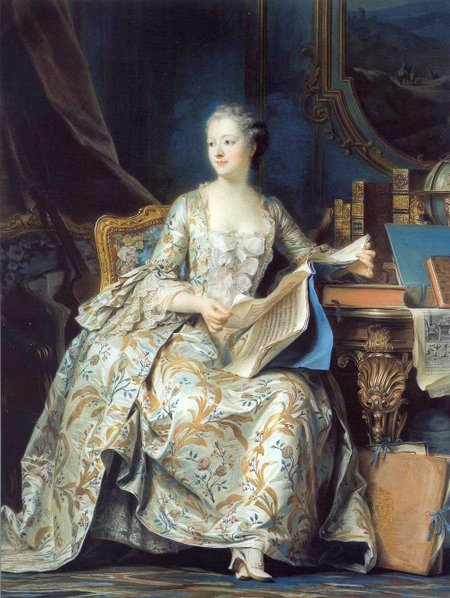Marquise de Pompadour 1570
- Born: 29 Dec 1721 1574
- Marriage (1): Louis XV King of France
- Marriage (2): Charles-Guilaume Le Normant d'Etiolles in 1741 1574
- Died: 15 Apr 1764 at age 42 1574
 Another name for Marquise was Jeanne-Antoinette Poisson.1574 Another name for Marquise was Jeanne-Antoinette Poisson.1574

 General Notes: General Notes:
Madame de Pompadour (December 29, 1721 - April 15, 1764) was the famous mistress of King Louis XV of France.
She was born Jeanne-Antoinette Poisson in 1721. It is suspected that her biological father was the rich financier Le Normant de Tournehem, who became her legal guardian when her official father was forced to leave the country in 1725 after a scandal and she lived with her mother and sister. She was intelligent and educated; she also learned to dance, engrave and to play guitar. She was married in 1741 (at the age of 19) to Charles-Guilaume Le Normant d'Etiolles, nephew of her guardian. With him, she had two children, a boy who died the year after his birth in 1741, and Alexandrine-Jeanne, born August 10, 1744, and nicknamed "Fanfan."
Contemporary opinion considered Madame de Pompadour quite beautiful, with her small mouth and oval face enlivened by her wit. Her young husband was soon mad about her and she reigned in the fashionable world of Paris.
She caught the eye of the monarch in 1745. A group of courtiers, including her father-in-law, endorsed her to Louis XV, who was still mourning the death of his second mistress, the Duchess of Châteauroux. Jeanne-Antoinette was invited to a royal masquerade ball in February 1745 that celebrated the marriage of the king's son. By March she had become a regular visitor, and the king installed her at Versailles. He also bought her Pompadour, the first of six residences. In July, Louis made her a marquise, had her legally separated from her husband, and on September 14 she was formally presented at court.
She kept to Louis' bed only a few years, but she was such a level-headed courtier that she was able to find him younger, prettier girls while she also retained a cordial relationship with the queen, Marie Leszczynska. Louis was lazy, and Madame de Pompadour prepared all business for the king's eye beforehand with the ministers, who met in her rooms at Versailles.
Madame de Pompadour was an accomplished woman, with a good eye for Rococo interiors. She had a keen interest in literature. She had known Voltaire before her ascendancy, and the playwright apparently advised her in her courtly role. Contrary to popular belief - and contemporary opinion - she never had much direct political influence, but she supported Belle-Isle and endorsed the Duke of Choiseul to the king. Choiseul, it should be noted, encouraged the basic shift in French foreign policy away from Prussia and towards France's hereditary rival, the Austrian Habsburgs. This alliance eventually brought on the Seven Years War, with all its disasters, the battle of Rosbach and the loss of New France (Canada); but Mme de Pompadour persisted in her support of these policies, and, when Bernis failed her, brought Choiseul into office and supported him in all his great plans, the Pacte de Famille, the suppression of the Jesuits, and the peace of Versailles that lost Canada. She also discreetly endorsed Diderot's Encyclopédie project.
Pompadour was a woman of verve and intelligence. She planned buildings like the Place de la Concorde and the Petit Trianon with her brother, the Marquis de Marigny.She employed the stylish marchands-merciers who were turning Chinese vases into ewers with gilt-bronze Rococo handles and were mounting writing tables with the new Sèvres porcelain plaques. Numerous other artisans, sculptors and portrait painters were employed, the court artist Jean-Marc Nattier, in the 1750s Francois Boucher, and later Francois-Hubert Drouais (illustration, right). Drouais has rendered her demurely at traditional lady's work with her tambour and embroidery silks, among luxurious fittings that include a Sèvres-mounted table with a goat's mask in the latest goût Grèc. She is not young, but there is freshness and sparkle to everything about her. There is no sign that she is sick and about to die.
Pompadour suffered two miscarriages in the 1740s but did not actually arrange lesser mistresses for the king's pleasure, as is popular belief. Although they did not sleep together after 1750, Louis XV remained devoted to her until her death in 1764 at the age of 43. At the time she was publicly blamed for the Seven Years' War.
The classic pink of Sèvres porcelain is rose de Pompadour. The Pompadour haircut is also named after her. The "Coupe de champgne" (french champagne glass) was supposedly first moulded on her breast. 1574

Marquise married Louis XV King of France, son of Louis Duke of Burgundy and Marie-Adélaïde of Savoy. (Louis XV King of France was born on 16 Feb 1710 in Versailles, Île-de-France, France and died on 10 May 1774.)

Marquise next married Charles-Guilaume Le Normant d'Etiolles in 1741.1574
|

 Another name for Marquise was Jeanne-Antoinette Poisson.
Another name for Marquise was Jeanne-Antoinette Poisson.